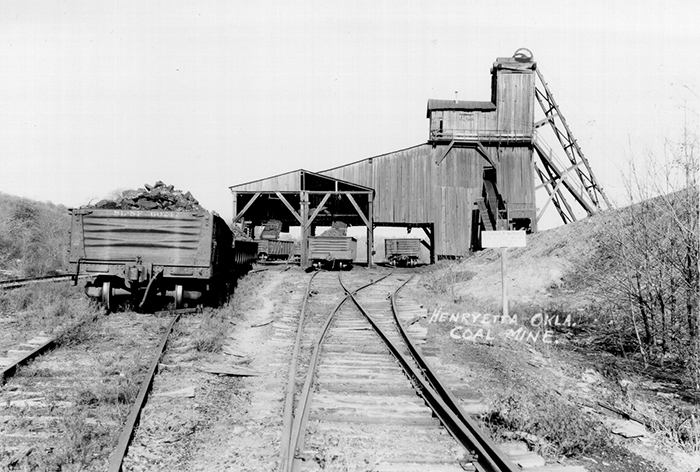The Encyclopedia of Oklahoma History and Culture
COAL LANDS, SEGREGATED.
In the early 1870s, when J. J. McAlester initiated the exploitation of coal deposits in the Choctaw Nation, Choctaw law designated that mineral "discoverers" such as McAlester could claim the resource for one mile in each direction and could lease it to another party. The arrival of the railroad in 1872 stimulated exploration for coal deposits. At first the railroad-controlled mines paid one-cent-per-ton royalty to the Choctaw Nation, but soon individuals such as McAlester and Tandy Walker won litigation that enabled them to receive the royalties. In 1883 a compromise agreement provided that the Choctaw and Chickasaw nations and the "discoverers" would each receive a percentage of the royalties. Previously, in 1880 it had been established that the Chickasaws would collect one-fourth of the Choctaw royalty. This also held for mining royalties collected in the Chickasaw Nation. This complex arrangement illustrated the era's changing economy and the changing relationships between individuals and tribal governments in the Indian nations. As Indian Territory mining operations expanded, Green McCurtain led a movement to make the coal mines national Choctaw property, thereby avoiding the "discovery lease" situation. In 1895 he sponsored such a bill, which failed to pass the Choctaw Council.
As the nineteenth century ended, the status of coal lands changed. With the Dawes Severalty Act, the federal government mandated the end of American Indian national governments, and the Dawes Commission worked to allot Indian lands to individuals. In the 1897 Atoka Agreement the Choctaw and Chickasaw governments agreed to the allotment. The pact was ratified by the Choctaw Nation but not by the Chickasaw Nation. The subsequent 1898 Curtis Act, which placed all residents of the Indian nations under federal law, and the act's 1902 supplement, provided for segregation (exemption from allotment) and eventual sale of coal lands. Between 1899 and 1902, 113 leases had been made, each to last thirty years. The United States Geological Survey suggested that a little more than 445,000 acres in the Choctaw Nation be segregated from the allotment process. In 1904, with the urging of Choctaw leadership, the U.S. government decided to sell the unleased land in 960-acre tracts, under sealed bids. However, deeming the bids inadequate, the Department of the Interior rejected them all. In 1906 the federal government withdrew all segregated coal lands from sale until the leases expired. At 1907 statehood Oklahoma made an effort to buy the lands, but a deal never materialized. In 1912 the federal government allowed the surface of these lands to be sold, but the Choctaw retained rights to the coal and asphalt deposits.
In 1918 the U.S. Congress approved an act to appraise and sell the coal deposits at public auctions for no less than the appraised value. The first public auction was held at McAlester in December 1918, and more of the leased tracts were sold than were the unleased. Each tract averaged about 853 acres. As oil had begun to capture the energy industry, the lands did not sell as well as hoped. In 1930 the Choctaw and Chickasaw nations still owned nearly 375,000 acres of segregated coal land. As the thirty-year leases expired, many were extended for fifteen years. The Choctaws continued to memorialize Congress to sell the lands at private sales.
In 1932 Sen. Elmer Thomas and Rep. Wilburn Cartwright introduced an unsuccessful bill that would have allowed the United States to buy the coal and asphalt, and the Indian governments continued to lobby for such a transaction. Finally, in 1947 the federal government offered $8.5 million for the segregated coal lands. After the Choctaw and Chickasaw enrollees approved the sale by vote and Congress approved the contract, the transfer occurred in June 1948. The proceeds were disbursed on a per capita basis to individual tribe members and heirs of deceased enrollees. As always, three-fourths went to the Choctaw Nation and one-fourth to the Chickasaw Nation. Because of the complicated past of these lands, in the mid- to late-twentieth century conflict often emerged when owners of the rights to the underground coal deposits had to negotiate with the rancher or farmer who owned the land above. In many cases the surface holder was unaware that they would have to allow a company to mine, usually strip mine, on their property.
See Also
CHOCTAW, COAL, JAMES JACKSON McALESTER, MINED LAND RECLAMATION, MINING AND MINERALS, OKLAHOMA ECONOMY
Learn More
Angie Debo, The Rise and Fall of the Choctaw Republic (Norman: University of Oklahoma Press, 1934).
Michael J. Hightower, "Cattle, Coal and Indian Land: A Tradition of Mining in Southeastern Oklahoma," The Chronicles of Oklahoma 42 (Spring 1984).
Citation
The following (as per The Chicago Manual of Style, 17th edition) is the preferred citation for articles:
Larry O'Dell, “Coal Lands, Segregated,” The Encyclopedia of Oklahoma History and Culture, https://www.okhistory.org/publications/enc/entry?entry=CO003.
Published January 15, 2010
© Oklahoma Historical Society


